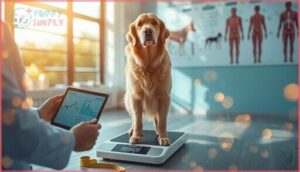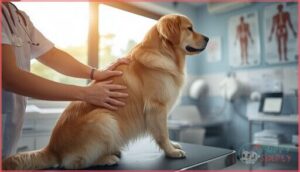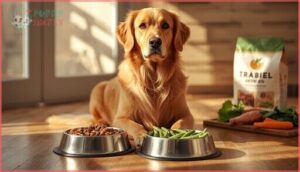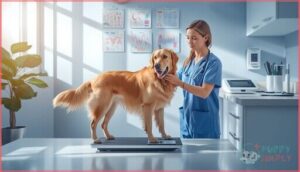This site is supported by our readers. We may earn a commission, at no cost to you, if you purchase through links.
Over half of all dogs in the United States carry excess weight, yet most owners don’t realize their pet has crossed the line from pleasantly plump to medically obese. The gap between perception and reality often widens as gradual weight gain becomes the new normal, making it harder to spot when your furry companion needs help.
Canine obesity isn’t just about appearance—it’s a serious health condition that shortens lifespan, increases arthritis risk, and reduces quality of life.
The good news? You have complete control over the most important factors: what goes in your dog’s bowl, how much exercise they get, and when they eat. Small, consistent changes in these areas can prevent obesity before it starts or reverse weight gain that’s already taken hold.
Table Of Contents
- Key Takeaways
- Recognizing Signs of Dog Obesity
- Choosing The Right Dog Food
- Managing Portions and Treats
- Implementing Regular Exercise Routines
- Encouraging Mental Stimulation and Healthy Habits
- Monitoring Health and Seeking Veterinary Guidance
- Frequently Asked Questions (FAQs)
- How can obesity in dogs be prevented?
- How to reduce dog weight naturally?
- What is the most effective way for a dog to lose weight?
- What foods make dogs overweight?
- Whats the best way to track my dogs weight?
- How do I know if my dog is hungry?
- Are there any weight-loss supplements for dogs?
- Can I give my dog weight-loss medication?
- How much weight should my dog lose per week?
- How does spaying or neutering affect dog weight?
- Conclusion
Key Takeaways
- Over half of US dogs are overweight, yet most owners don’t recognize the problem because gradual weight gain becomes normalized—catching early signs like decreased energy, difficulty feeling ribs, or loss of a visible waistline prevents serious health consequences that shorten lifespan.
- The right nutrition matters more than quantity: choose foods with at least 24% protein and 12-28% fiber to preserve muscle while promoting fullness, and limit treats to just 10% of daily calories since some contain over 70 calories each.
- Consistent daily exercise (30-60 minutes) tailored to your dog’s breed and age, combined with mental enrichment through puzzle feeders and interactive toys, prevents boredom eating while naturally controlling caloric intake.
- Partner with your veterinarian for regular Body Condition Score assessments and personalized calorie plans, since 81-85% of owners underestimate their dog’s weight and underlying conditions like hypothyroidism can sabotage weight loss efforts.
Recognizing Signs of Dog Obesity
You might notice your dog’s collar getting tighter or feel extra padding where their ribs used to be easy to find. These subtle changes can be easy to miss in the day-to-day, but catching them early gives you the chance to step in before weight gain becomes a bigger health concern.
Let’s walk through the key signs to watch for, starting with how to spot unhealthy weight gain in your dog.
Identifying Unhealthy Weight Gain
How do you spot unhealthy weight gain before it becomes a serious problem? Early warning signs often appear gradually, making owner awareness paramount. Veterinary assessments provide objective evaluation, but you can monitor your dog’s condition at home:
- Decreased energy and less interest in exercise or play
- Difficulty feeling ribs through the chest wall
- Loss of a visible waistline when viewed from above
- Fatigue during previously manageable activities
- Needing to loosen collars or harnesses regularly
Recognizing these indicators early helps prevent dog obesity and its health consequences. Up to 65% of dogs in the U.S. are considered overweight or obese.
Body Condition Scoring for Dogs
Body condition scoring in dogs gives you a structured way to evaluate your pet’s weight at home. The 9-point BCS scale, ranging from emaciated (1) to morbidly obese (9), is the most common scoring system in clinical use. An ideal body condition falls at 4 or 5, where you can feel ribs easily and see a clear waistline.
Understanding dog body condition matters because owner perception often misses obesity—research shows 81–85% of owners underestimate their overweight dog’s BCS, even with charts. This BCS accuracy gap means many dogs don’t get help until health problems develop. Breed variation also affects scoring, since body types differ greatly between, say, Greyhounds and Bulldogs.
Most dog owners underestimate their pet’s weight by up to 85%, missing obesity until serious health problems emerge
When you combine visual assessment with palpation—checking rib coverage and fat deposits—you’ll get reliable results. Regular body condition assessments are essential for tracking weight management progress. Healthy body condition scoring helps you to catch weight gain early, before obesity in dogs shortens your companion’s life or causes joint damage.
Common Causes of Canine Obesity
Once you understand how to assess your dog’s body condition, you’ll want to know what drives weight gain in the first place. Obesity in dogs develops from multiple factors working together, creating a perfect storm for overweight dogs:
- Dietary imbalance: High-fat, low-protein foods and excessive treats (often exceeding 20% of daily calories)
- Inactivity levels: Less than one hour of daily exercise nearly doubles obesity risk
- Genetic factors: Breeds like Labradors and Beagles show higher predisposition to pet obesity
- Owner habits: Free-choice feeding and table scraps contribute greatly to weight problems
- Medical issues: Hypothyroidism, Cushing’s disease, and certain medications affect metabolism
These health issues often overlap, so identifying your dog’s specific triggers helps you create an effective prevention plan.
Choosing The Right Dog Food
Think of your dog’s food as the foundation of their health—it’s not just about filling the bowl, but choosing what goes in it. The right diet can help your dog maintain a healthy weight, while the wrong one can quietly add pounds over time.
Let’s look at two key factors that’ll guide you toward making smarter food choices for your pet.
Selecting Nutrient-dense, Balanced Diets
Picking the right dog nutrition and diet starts with understanding what your pet truly needs. A balanced diet for dogs should include at least 24% crude protein to preserve lean muscle, while dietary fiber—around 12-28%—helps your dog feel full and satisfied.
Quality diet options from commercial sources that meet AAFCO standards provide reliable, balanced nutrition with appropriate energy density. If you’re considering homemade adequacy, know that 62% of home-prepared meals lack critical nutrients.
Whether choosing commercial options or crafting meals yourself, meeting your dog’s nutritional needs prevents weight gain while supporting overall health.
Considering Weight Management Formulas
When your dog’s weight creeps up despite your best efforts, weight management formulas offer clinically proven results. Studies show that 57.5% of dogs achieved weight loss on prescription diets versus 42.2% on standard options.
These specialized formulas contain increased protein and amino acids to protect muscle while reducing calorie intake, plus added L-carnitine and fiber to promote satiety.
Your veterinarian can recommend options like Hill’s Prescription Diet Metabolic, which helped 94% of dogs lose an average of 14.5% body weight through carefully controlled nutritional needs and portion control.
Managing Portions and Treats
Even with the right food, your dog can still gain weight if you’re serving too much or handing out treats without a second thought. Portion control isn’t about depriving your pet—it’s about giving them exactly what their body needs to thrive.
Let’s look at practical ways to measure meals, rein in treat calories, and choose healthier rewards that won’t sabotage your dog’s weight goals.
Measuring Food for Accurate Portions
Accurate portion control starts with the right tools. Digital kitchen scales deliver the most reliable results, ensuring your dog’s calorie intake matches feeding guidelines precisely.
If you prefer standardized cups, level the kibble to avoid overestimation—generic household cups can overestimate portions by up to 80%. Consistent measurement matters, especially since calorie density varies between foods. Measure food daily to prevent gradual weight gain.
Limiting High-calorie Treats
Many owners don’t realize treats pack a caloric punch—some jerky strips contain over 70 calories each. Since veterinarians recommend treats comprise no more than 10% of your dog’s daily calorie intake, reading treat labels becomes essential for portion control.
If your dog needs 1,000 calories daily, limit treats to 100 calories maximum. Monitoring treat calorie density aids effective weight management and prevents unintended overfeeding.
Healthy Treat Alternatives Recommended by Experts
Swapping calorie bombs for nutrient-dense options keeps your dog satisfied without sabotaging weight goals. Fiber-rich treats like green beans and pumpkin promote fullness, while protein-packed snacks support lean muscle. Low-calorie chews such as frozen carrots offer satisfying crunch under 25 calories. Natural treat options—watermelon, blueberries, or cucumber slices—deliver vitamins without excess fat.
Healthy snacks and veggies work when you practice portion control, ensuring treats remain rewards, not meal replacements.
Implementing Regular Exercise Routines
Getting your dog moving is one of the most powerful tools you have to fight obesity and keep them healthy for years to come. The right exercise routine isn’t one-size-fits-all, though—what works for a young Border Collie won’t be the same as what’s best for a senior Bulldog.
Let’s look at how to create a safe, effective activity plan that fits your dog’s unique needs.
Tailoring Exercise to Breed and Age
Just like you wouldn’t ask a marathon runner and a chess player to train the same way, your dog’s exercise routine needs to match their breed energy levels and age-related limitations.
Puppies require gentler physical activity with safe programming to protect growing joints, while senior dogs benefit from low-impact sessions.
Customized outcomes improve dramatically when you adjust exercise intensity based on your dog’s unique needs, preventing injury while fighting obesity effectively.
Daily Physical Activity Recommendations
Your dog needs at least 30 minutes of aerobic exercise daily, though most veterinarians recommend 30 to 60 minutes spread across multiple sessions. Brisk walking, playing with other dogs, and swimming are excellent activity types that promote cardiovascular health.
Dogs exercised more than once daily have lower odds of being overweight, showing the observed impact of consistent physical activity on preventing obesity and improving overall health.
Safe Ways to Increase Your Dog’s Activity
Now that you’ve established a daily exercise routine, it’s time to ramp up your dog’s activity safely. Gradual introduction is key—start with short, frequent sessions before progressing to longer durations to minimize injury risk.
Interactive games like fetch and tug-of-war boost activity while strengthening your bond. Use positive reinforcement to motivate participation, and incorporate environmental novelty by changing walking routes regularly.
Essential safety measures include avoiding high-impact surfaces and monitoring for fatigue during exercise.
Encouraging Mental Stimulation and Healthy Habits
Keeping your dog’s mind active plays a bigger role in weight management than many owners realize. When dogs are mentally engaged, they’re less likely to turn to food out of boredom or stress.
Let’s explore three practical strategies that combine mental enrichment with healthy eating habits to support your dog’s weight goals.
Using Interactive Feeding Toys
Introducing interactive toys and puzzle feeders into your dog’s mealtime transforms eating from a passive activity into an engaging challenge. These tools extend eating duration from just 2–3 minutes to 5–10 minutes, boosting physical activity and mental stimulation while naturally controlling caloric intake.
With 83% user adoption among enrichment-focused pet owners, feeding toys have become a cornerstone of effective dog weight management strategies.
Enrichment Activities to Prevent Overeating
Beyond feeding toys, you can prevent boredom eating through scent games, structured training sessions, and varied play. Mental stimulation reduces stress-related overeating, while puzzle feeders extend mealtime. Try these strategies:
- Rotate interactive toys weekly to maintain novelty
- Create DIY snuffle mats for foraging activity
- Incorporate nose work with low-calorie rewards
- Schedule daily enrichment sessions alongside exercise
Structured programs combining these activities support lasting weight management.
Consistent Feeding Schedules and Mealtimes
Beyond games and toys, when you feed your dog matters just as much as what you serve. Scheduled feeding benefits include better portion control and weight maintenance—research shows dogs fed once or twice daily at consistent mealtimes have lower obesity rates than free-fed pets.
Measure food carefully, stick to regular morning and evening meals, and get your whole family on board with the same routine.
Monitoring Health and Seeking Veterinary Guidance
Keeping your dog at a healthy weight isn’t something you can do alone—your veterinarian is your most valuable partner in this journey. Regular check-ins, honest conversations about calories, and addressing any underlying health issues will help you stay on track.
Let’s look at three key ways your vet can support your dog’s weight management goals.
Regular Weight and Health Assessments
Keeping track of your dog’s weight isn’t just good practice—it’s essential for catching problems early. Veterinary checkups should include formal Body Condition Score assessments at every visit, helping you and your vet monitor changes over time. Here’s what effective monitoring looks like:
- Schedule annual veterinary checkups, even if your dog seems healthy
- Request Body Condition Score evaluations during each visit
- Learn the BCS scale (1-9) to improve your assessment accuracy at home
- Track weight weekly or bi-weekly if your dog’s on a weight management plan
- Keep a medical record with photos to document your dog’s progress objectively
Regular assessment frequency matters because breed trends show weight changes vary considerably—some breeds gain 2-14% while others lose weight naturally. Unfortunately, owner compliance remains challenging, with less than half believing annual exams are necessary. Veterinary protocols recommend honest BCS accuracy checks, since studies show 46% of owners misjudge normal-weight dogs as underweight. Following veterinarian recommendations for routine monitoring helps you catch weight gain before it becomes a serious health issue.
Discussing Ideal Caloric Intake With Your Vet
When you visit your veterinarian, bring detailed feeding records—including treats and table scraps—so they can calculate your dog’s RER and apply appropriate MER multipliers for a custom daily calorie plan.
Your vet will perform a BCS assessment to determine if weight-loss diets are needed, then provide veterinarian recommendations for calorie intake adjustments. This collaboration ensures you’re feeding the right amount for your dog’s unique needs.
Addressing Medical Conditions That Impact Weight
Sometimes obesity isn’t about food or exercise—underlying medical conditions can sabotage your dog’s weight, even with perfect care. Your veterinarian will screen for health problems like:
- Hypothyroidism effects that slow metabolism and cause weight gain
- Cushings syndrome, redistributing fat to the abdomen
- Osteoarthritis impact, reducing activity due to pain
- Seizure medication that increases appetite
- Health conditions requiring specific treatment plans
Early diagnosis protects your dog’s future.
Frequently Asked Questions (FAQs)
How can obesity in dogs be prevented?
Think of obesity prevention like steering a ship—small, consistent adjustments in diet, exercise, and portion control keep your dog on course toward a healthy weight.
Early intervention and owner education make lifestyle changes stick.
How to reduce dog weight naturally?
Natural weight loss for dogs combines gradual exercise increase, calorie restriction through a structured weight loss plan, and proper hydration.
This comprehensive dog health approach helps achieve gradual weight loss, targeting 1-3% of body weight weekly.
What is the most effective way for a dog to lose weight?
The most effective way for a dog to lose weight combines calorie restriction with a veterinarian-designed weight loss plan, consistent monitoring, and an exercise regimen.
Dietary strategies, exercise for dogs, and behavior modification work together best.
What foods make dogs overweight?
High-calorie kibble, table scraps, sugary treats, and starch-rich diets cause weight gain when portions aren’t controlled.
Mixed feeding and human food dangers include hidden calories that exceed your dog’s energy needs, making pet food energy density essential.
Whats the best way to track my dogs weight?
While daily fluctuations happen, weekly weigh-ins using the same scale at consistent times provide reliable trends.
Combine body weight checks with monthly body condition scores, digital tools, and regular veterinary care for thorough weight management and healthy outcomes.
How do I know if my dog is hungry?
Physiological cues like stomach gurgling before meals, along with pacing near the bowl around scheduled mealtimes, suggest genuine hunger.
However, begging behaviors often reflect learned habits rather than true hunger, increasing obesity risk when misinterpreted.
Are there any weight-loss supplements for dogs?
Yes, weight-loss supplements exist for dogs, but don’t expect miracle pills. Veterinary guidelines emphasize diet and exercise first, since supplements like L-carnitine show modest efficacy at best and carry adverse reaction risks without proper veterinarian oversight.
Can I give my dog weight-loss medication?
Weight-loss medication for dogs exists, but it’s not a first-line solution. Your veterinarian may prescribe dirlotapide only after diet and exercise haven’t worked, requiring careful veterinary oversight and monitoring for drug side effects.
How much weight should my dog lose per week?
Like a ship adjusting its course gradually, your dog’s weight loss plan should target about 1–2% of their current body weight per week.
Your veterinarian can calculate the safe loss range and monitor progress closely.
How does spaying or neutering affect dog weight?
Spaying or neutering changes hormone levels, which can slow your dog’s metabolism and increase appetite. These metabolic shifts mean your dog needs fewer calories post-surgery, making weight gain more likely without dietary adjustments.
Conclusion
Just as an ounce of prevention beats a pound of cure, the dog obesity prevention tips you’ve learned today can spare your companion years of discomfort and declining health.
You now hold the blueprint for keeping your dog lean, active, and thriving through every life stage.
Start with one change—measuring meals, swapping treats, or adding a daily walk—and watch those small steps compound into significant results that extend your dog’s healthiest years.
- https://www.petobesityprevention.org/articlesandnews/7rgaffzvl03ypt9sbgted88yjnd6c2
- https://en.allpetfood.net/entrada/us-majority-of-pet-owners-still-underestimate-pet-obesity-55170
- https://www.ukpetfood.org/resource/obesity-report-released-to-tackle-rising-pet-obesity.html
- https://pmc.ncbi.nlm.nih.gov/articles/PMC6488012/
- https://www.rover.com/blog/much-exercise-dog-need/















